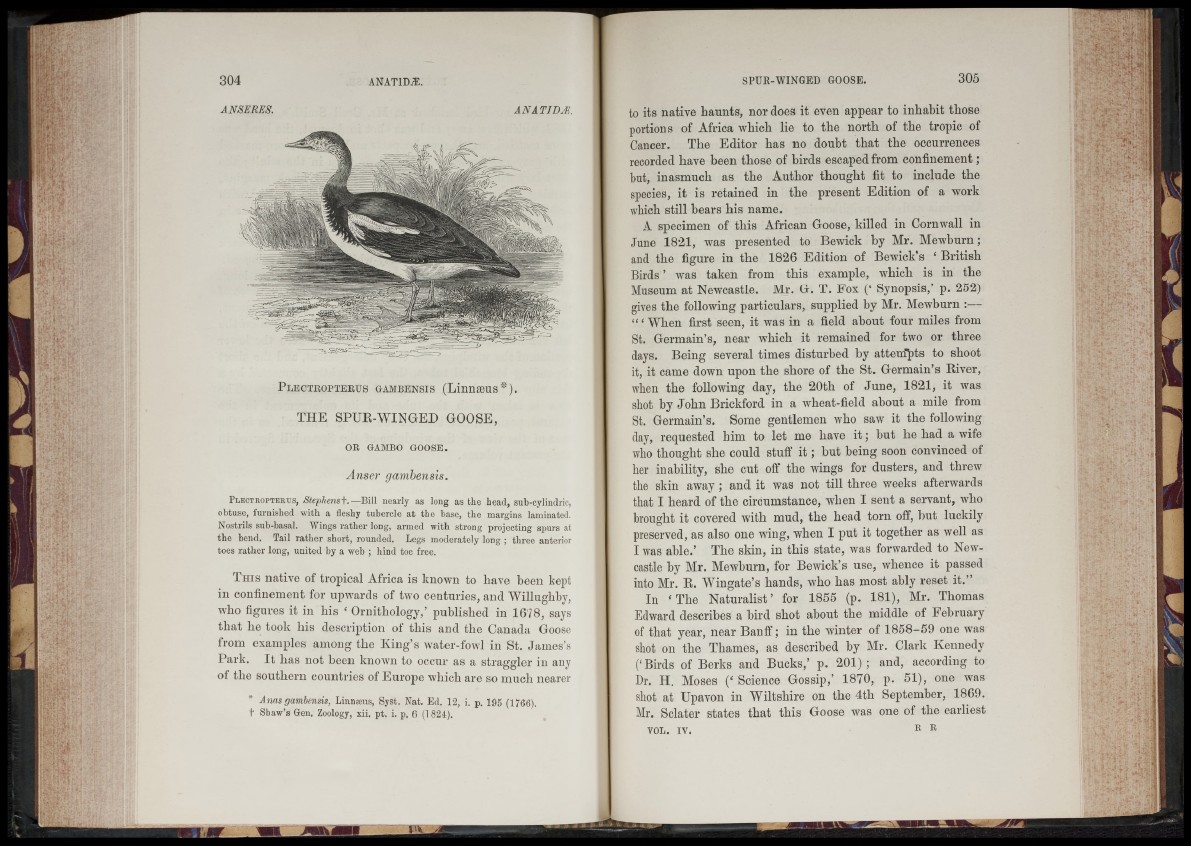
A NSERES. AN ATIDyR.
P lectropterus gambensis (Linnaeus*).
THE SPUR-WINGED GOOSE,
OR GAMBO GOOSE.
Anser gambensis.
P lectropterus, Stephenst . —Bill nearly as long as the head, sub-cylindric,
obtuse, furnished with a fleshy tubercle at the base, the margins laminated.
Nostrils sub-basal. Wings rather long, armed with strong projecting spurs at
the bend. Tail rather short, rounded. Legs moderately loDg ; three anterior
toes rather long, united by a web ; hind toe free.
This native of tropical Africa is known to have been kept
in confinement for upwards of two centuries, and Willugliby,
who figures it in his ‘ Ornithology,’ published in 1678, says
that he took his description of this and the Canada Goose
from examples among the King’s water-fowl in St. James’s
Park. It has not been known to occur as a straggler in any
of the southern countries of Europe which are so much nearer
* Anas gambensis, Linnaeus, Syst. Nat. Ed. 12, i. p. 195 (1766).
1' Shaw’s Gen. Zoology, xii. pt. i. p. 6 (1824).
to its native haunts, nor does it even appear to inhabit those
portions of Africa which lie to the north of the tropic of
Cancer. The Editor has no doubt that the occurrences
recorded have been those of birds escaped from confinement;
but, inasmuch as the Author thought fit to include the
species, it is retained in the present Edition of a work
which still hears his name.
A specimen of this African Goose, killed in Cornwall in
June 1821, was presented to Bewick by Mr. Mewburn;
and the figure in the 1826 Edition of Bewick’s ‘ British
Birds ’ was taken from this example, which is in the
Museum at Newcastle. Mr. G. T. Fox (‘ Synopsis,’ p. 252)
gives the following particulars, supplied by Mr. Mewburn :—
“ ‘ When first seen, it was in a field about four miles from
St. Germain’s, near which it remained for two or three
days. Being several times disturbed by attenfpts to shoot
it, it came down upon the shore of the St. Germain’s River,
when the following day, the 20th of June, 1821, it was
shot by John Brickford in a wheat-field about a mile from
St. Germain’s. Some gentlemen who sawT it the following
day, requested him to let me have i t ; but he had a wife
who thought she could stuff i t ; hut being soon convinced of
her inability, she cut off the wings for dusters, and threw
the skin away ; and it was not till three weeks afterwards
that I heard of the circumstance, when I sent a servant, who
brought it covered with mud, the head torn off, hut luckily
preserved, as also one wing, when I put it together as well as
I was able.’ The skin, in this state, was forwarded to Newcastle
by Mr. Mewburn, for Bewick’s use, whence it passed
into Mr. R. Wingate’s hands, who has most ably reset it.”
In ‘ The Naturalist’ for 1855 (p. 181), Mr. Thomas
Edward describes a bird shot about the middle of February
of that year, near Banff; in the winter of 1858-59 one was
shot on the Thames, as described by Mr. Clark Kennedy
(‘Birds of Berks and Bucks,’ p. 201); and, according to
Dr. H. Moses (‘ Science Gossip,’ 1870, p. 51), one was
shot at Upavon in Wiltshire on the 4th September, 1869.
Mr. Sclater states that this Goose was one of the earliest
VOL. IV. R R